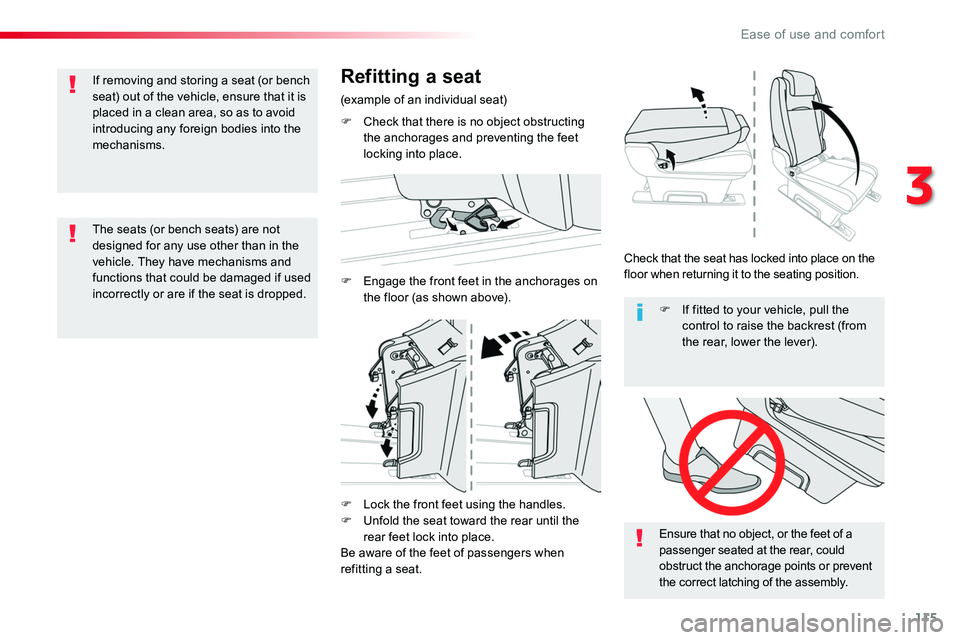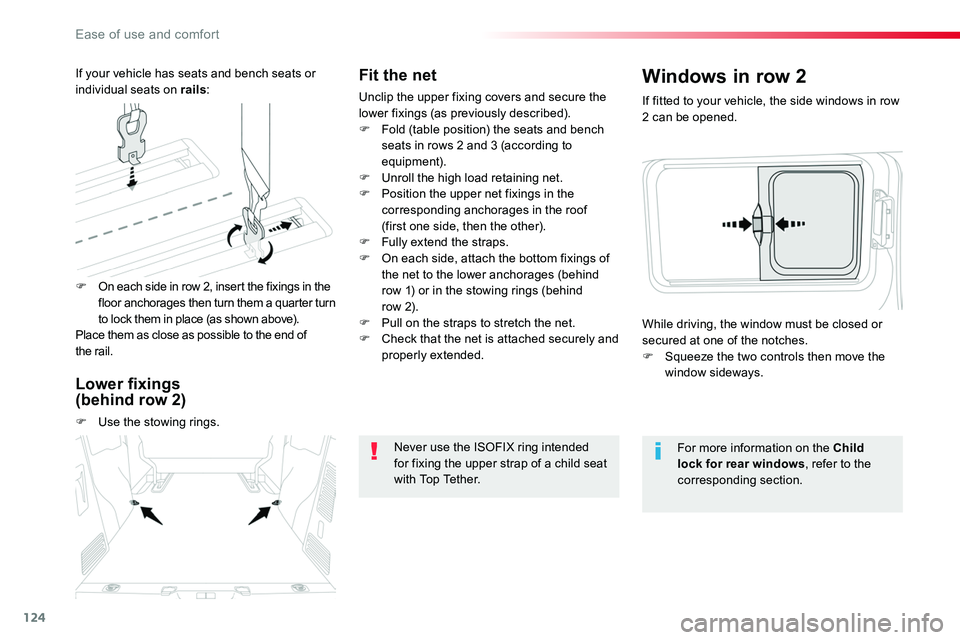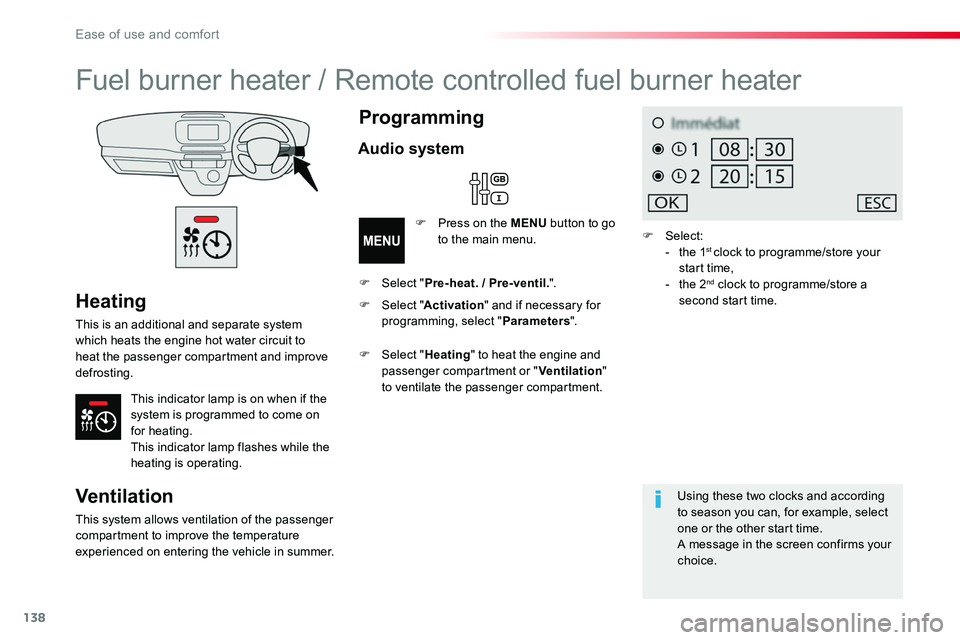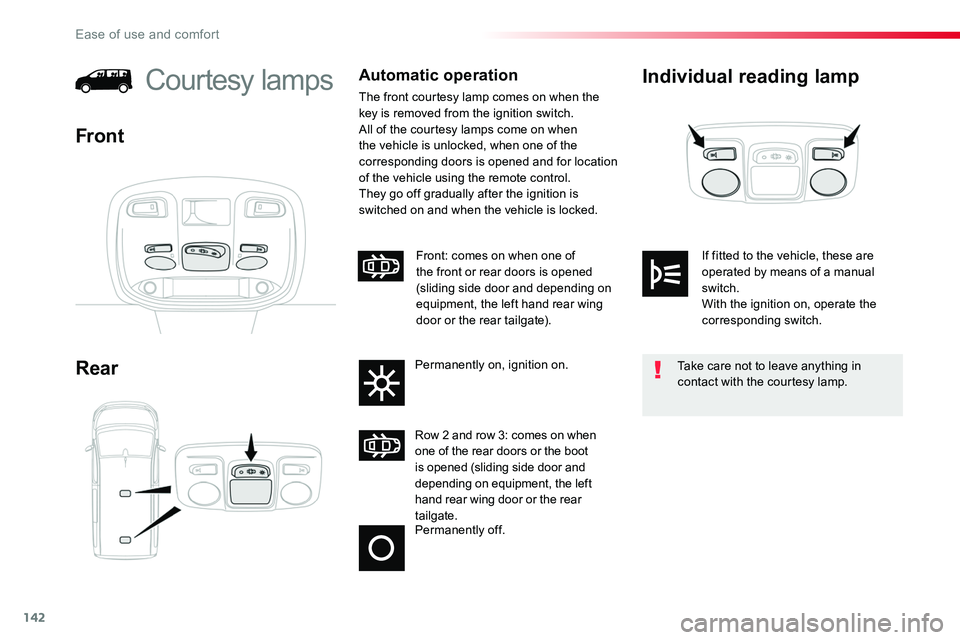Page 108 of 516
108
Lowering the seat cushion
F Remove the non-slip net.F To reposition the seat cushion, press firmly
at the top of the seat with one hand to lower the seat cushion until it engages in the seating position.
Non-slip net
Fitting the net
F Place the first fixing in the upper cut-out 1, located on the folded cushion. Then turn it a quarter turn clockwise to secure it.F Place the second fixing in the lower cut-out 2, located on the seat support. Then turn it a quarter turn clockwise to secure it.
F Engage the first hook on the ring 3, located
in the open glove box.F Engage the second hook on the ring 4, located on the floor.
Removing the net
F Remove the hooks from the rings 4 and 3.F Remove the lower 2 then upper fixing 1, by turning them a quarter turn anti-clockwise to release them.
Ease of use and comfort
Page 111 of 516
111
F If your vehicle has the facility, place the seat backrest in the table position.
F Release the front feet using these handles.F Disengage the seat from its anchorages.F Remove the seat.
F If your vehicle has the facility, place the backrest in the table position.F Tip the seat for ward.
Tipping, access to row 3Removing a seat
It is not necessary to fold the backrest (table position) to tip the bench seat for access to row 3.
F Using the handle, release the rear feet then tip the seat for ward.F To return the seat, tip the bench towards the rear until the feet lock into place.
If removing and storing a bench seat out of the vehicle, ensure that it is placed in a clean area, so as to avoid introducing any foreign bodies into the mechanisms.
The bench seats are not designed for any use other than in the vehicle. They have mechanisms and functions that could be damaged if used incorrectly or are dropped.
3
Ease of use and comfort
Page 112 of 516
112
F If your vehicle has the facility, pull the control and raise the backrest (from the rear, lower the lever).
Check that the seat has correctly engaged in its anchorages on the floor when returned to the seating position.
Ensure that no object, or the feet of a passenger seated at the rear, could obstruct the anchorage points or prevent the correct latching of the assembly.
F Check that there is nothing obstructing the anchorages or which would prevent the correct engagement of the feet.
Refitting a seat
F Lock the front feet using the handles.F Tip the seat toward the rear until the rear feet lock into place.
Be aware of the feet of any passengers while tipping the seat.
F Engage the front feet in the anchorages in the floor (as shown above).
Ease of use and comfort
Page 115 of 516

115
F Lock the front feet using the handles.F Unfold the seat toward the rear until the
rear feet lock into place.Be aware of the feet of passengers when refitting a seat.
Ensure that no object, or the feet of a passenger seated at the rear, could obstruct the anchorage points or prevent the correct latching of the assembly.
F If fitted to your vehicle, pull the control to raise the backrest (from the rear, lower the lever).
The seats (or bench seats) are not designed for any use other than in the vehicle. They have mechanisms and functions that could be damaged if used incorrectly or are if the seat is dropped.
If removing and storing a seat (or bench seat) out of the vehicle, ensure that it is placed in a clean area, so as to avoid introducing any foreign bodies into the mechanisms.
Refitting a seat
(example of an individual seat)
F Check that there is no object obstructing the anchorages and preventing the feet locking into place.
F Engage the front feet in the anchorages on the floor (as shown above).
Check that the seat has locked into place on the floor when returning it to the seating position.
3
Ease of use and comfort
Page 124 of 516

124
Fit the net
Unclip the upper fixing covers and secure the lower fixings (as previously described).F Fold (table position) the seats and bench seats in rows 2 and 3 (according to equipment).F Unroll the high load retaining net.F Position the upper net fixings in the corresponding anchorages in the roof (first one side, then the other).F Fully extend the straps.F On each side, attach the bottom fixings of the net to the lower anchorages (behind row 1) or in the stowing rings (behind row 2).F Pull on the straps to stretch the net.F Check that the net is attached securely and properly extended.
Never use the ISOFIX ring intended for fixing the upper strap of a child seat with Top Tether.
If fitted to your vehicle, the side windows in row 2 can be opened.
Windows in row 2
For more information on the Child lock for rear windows, refer to the corresponding section.
While driving, the window must be closed or secured at one of the notches.F Squeeze the two controls then move the window sideways.
F On each side in row 2, insert the fixings in the floor anchorages then turn them a quarter turn to lock them in place (as shown above).Place them as close as possible to the end of the rail.
If your vehicle has seats and bench seats or individual seats on rails:
Lower fixings (behind row 2)
F Use the stowing rings.
Ease of use and comfort
Page 138 of 516

138
Heating
This is an additional and separate system which heats the engine hot water circuit to heat the passenger compartment and improve defrosting.
This indicator lamp is on when if the system is programmed to come on for heating.This indicator lamp flashes while the heating is operating.
Fuel burner heater / Remote controlled fuel burner heater
Ventilation
This system allows ventilation of the passenger
compartment to improve the temperature experienced on entering the vehicle in summer.
Programming
Audio system
F Press on the MENU button to go to the main menu.
F Select "Pre-heat. / Pre-ventil.".
F Select "Heating" to heat the engine and passenger compartment or "Ventilation" to ventilate the passenger compartment.
F Select:- the 1st clock to programme/store your start time,- the 2nd clock to programme/store a second start time.
Using these two clocks and according to season you can, for example, select one or the other start time.
A message in the screen confirms your choice.
F Select "Activation" and if necessary for programming, select "Parameters".
Ease of use and comfort
Page 141 of 516
141
Permanently off.
Comes on when one of the front or rear doors is opened.
Permanently on, ignition on.Rear
Courtesy lamp(s)
Front
Take care to not place anything in contact with the courtesy lamp.
Automatic switching on/off
The front courtesy lamp comes on when the key is removed from the ignition.All of the courtesy lamps come on when the vehicle is unlocked, when one of the corresponding doors is opened and for location of the vehicle using the remote control.They switch off gradually after the ignition is switched on and when the vehicle is locked.
3
Ease of use and comfort
Page 142 of 516

142
Individual reading lamp
Rear
Courtesy lampsAutomatic operation
The front courtesy lamp comes on when the key is removed from the ignition switch.All of the courtesy lamps come on when the vehicle is unlocked, when one of the corresponding doors is opened and for location of the vehicle using the remote control.They go off gradually after the ignition is switched on and when the vehicle is locked.
Front
Permanently off.
Row 2 and row 3: comes on when one of the rear doors or the boot is opened (sliding side door and depending on equipment, the left hand rear wing door or the rear tailgate.
Front: comes on when one of the front or rear doors is opened (sliding side door and depending on equipment, the left hand rear wing door or the rear tailgate).
Permanently on, ignition on.Take care not to leave anything in contact with the courtesy lamp.
If fitted to the vehicle, these are operated by means of a manual switch.With the ignition on, operate the corresponding switch.
Ease of use and comfort